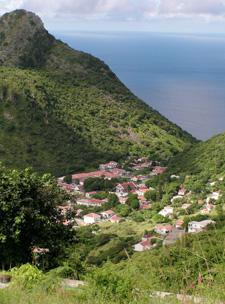When the Twin Otter clanks down on Saba’s tiny runway after a 20-minute flight from St Maarten, a crisp rainbow spreads across the sky like a multicoloured lipstick grin. It raises the question: How has this obscure, tiny island with little nightlife garnered rave reviews as a gay-friendly destination?
“Be careful of what you say to the Sabans,” warns the lady sitting beside me on the plane. “They’re always talking to each other.”
That’s what I see them doing as I stroll the quiet lanes of Windwardside, the second largest village. Everyone lives in matching white cottages that cling to the vertical hills, with an upward view of a cloud-topped mountain and a downward view of the ocean.
I’m on my way to meet Glenn Holm, the director of tourism, who’s going to show me around the village. He has a rainbow flag flapping proudly over his cottage and he seems unconcerned that I can see into his backyard from my guesthouse.
Glenn is descended from Swedish pirates, he explains, flipping his ponytail, and he also has some African ancestry. He was one of the first gay men to come out on the island, making him part of the local history, other parts of which he recounts as we walk to the museum. You’re just as likely to get somewhere via a lush jungle trail as on a road, and so we take the Breadfruit Trail. On the way he crumbles a shiny bay rum leaf that smells like cinnamon.
Later that day I meet Carl Buncamper, who also has a ponytail and a rainbow flag on his cottage. He’s on the governing Island Council and coordinates the AIDS Support Group Saba, among other things.
I guess Carl is one of those talking-to-each-other islanders I’m supposed to be careful around because he clearly believes in communication. Saba is an accepting place, he explains, because of the interdependence created in such an isolated location. “People had to deal with each other. You had to get food, whether you were gay or straight.” He’s impressed by the determination and strong character of those who went before. Early residents had to carry all their belongings (including pianos) up the mountain via a steep stone staircase from the harbour called “The Ladder.”
The next day I decide to give myself a taste of the life by hiking a trail that used to be a major thoroughfare between Windwardside and the largest village called The Bottom. It’s a two-hour commute alongside elephant ear ferns with leaves taller than me. I scramble up slippery rock stairs, toward the heights of Mount Scenery, and then turn and follow the Crispeen Track through jungle, fields and jaw-dropping views. Saba has no real beach; visitors spend their time hiking and diving among reefs and lava tunnels.
That night I meet a lesbian named Debbie, who tells me she got some flack from islanders, years ago, when the government denied immigration status to her Dutch girlfriend at the time and she hired a lawyer and won.
“In the beginning there was some hostility and then it was okay,” she says.
The island has opened up a lot since then, and Debbie and her girlfriend hold hands and dance together in public spaces. During my visit I meet out gay and lesbian businesspeople, road maintenance workers, medical students and activists. They are mostly white; Chulani Levenstone, a young multiracial islander says young gay and lesbian people of colour face additional pressures. Everything is up in the air these days, including same-sex marriage recognition, while Saba negotiates its new constitution. Stay tuned.

 Why you can trust Xtra
Why you can trust Xtra